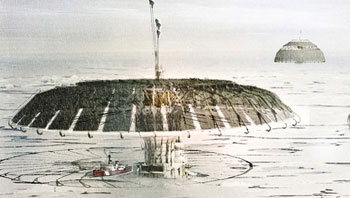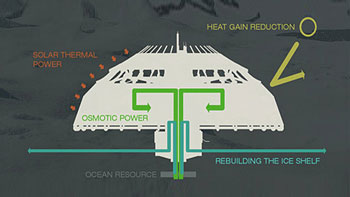An architect has won first prize for a building design that’s intended to help rebuild the Arctic ice caps.
Derek Pirozzi’s "Polar Umbrella" is the winning skyscraper in this year’s eVolo’s Magazine’s competition.
His design is based on giant, floating umbrellas that can potentially restore ice by harvesting and freezing the water underneath.
"This simple and bold umbrella feature of the design allows for the large structure to operate like a large arctic buoy, floating amongst the ice, producing copious amounts of replenished arctic surface helping to rebuild the fractured polar shelf," Pirozzi told Wired.
Strategically placed in the fastest melting areas of the Arctic or Antarctic, these large shading devices, which he calls "flexible mushroom-like exoskeletons," would provide shade and absorb UV rays – converting them into solar energy, instead of allowing them to melt the ice.
His wonderfully optimistic concept is that this self-sustaining structure would not be permanently placed – it would reconstitute the ice and keep moving to those areas in most need of more, thick ice.

"Rebuilding our protective Northern and Southern layers must become a primary objective," says Pirozzi. We must begin to help cool the earth’s surface once again by reducing heat gain in our vulnerable arctic regions. By producing large amounts of ice and through the thickening of our current ice shelf, we can begin to rejuvenate the current ice packs."
A system of pliable pipes in the mushroom’s "thermal skin" would harvest seawater by pumping it up and producing solar energy that powers the building.
Buoyant underwater chambers keep the umbrella afloat and by removing the seawater, the ice caps would re-freeze.
Since the umbrella is "double jointed," it can be angled to catch the most sunshine. And that would cause the surrounding area’s temperature to drop by three degrees Celsius.
The umbrella is constructed from carbon-based zinc-coated steel, which allows it to flexible enough to withstand harsh, icy winds.

The building would mainly host research labs, with dorms for 200 researchers and tourists.
Established in 2006, the competition recognizes outstanding ideas for vertical living through the novel use of technology, materials, programs, aesthetics, and spatial organization.
Learn more about Derek Pirozzi:
